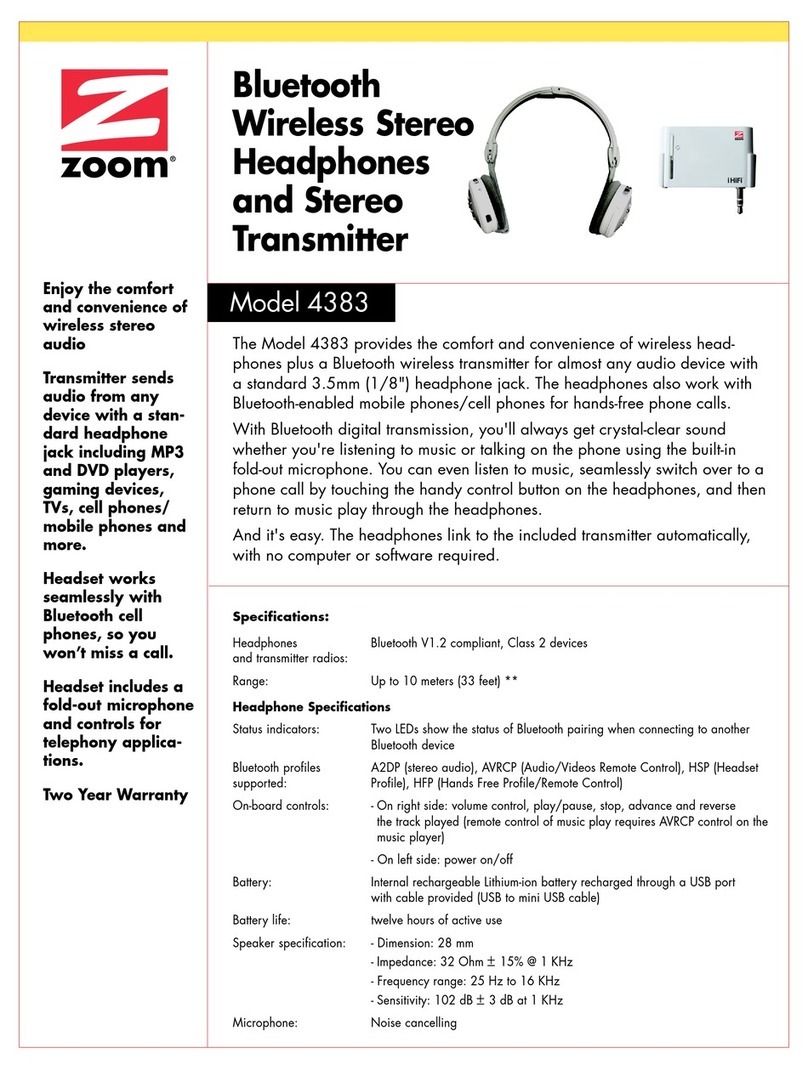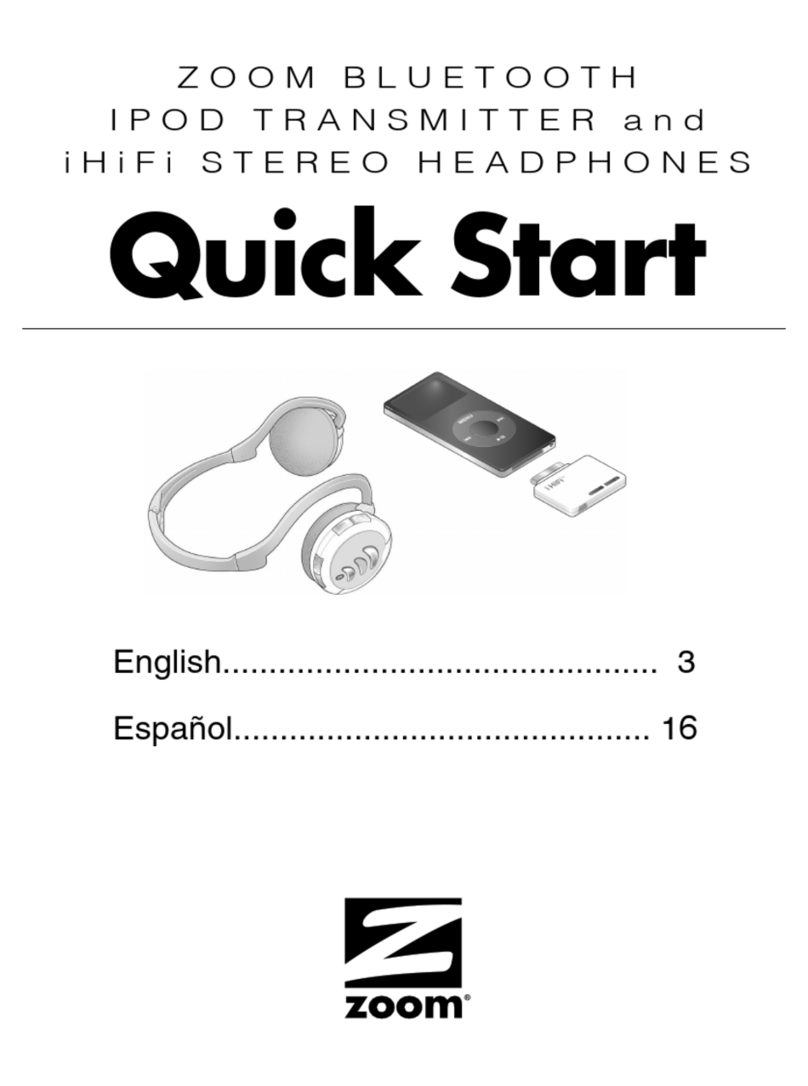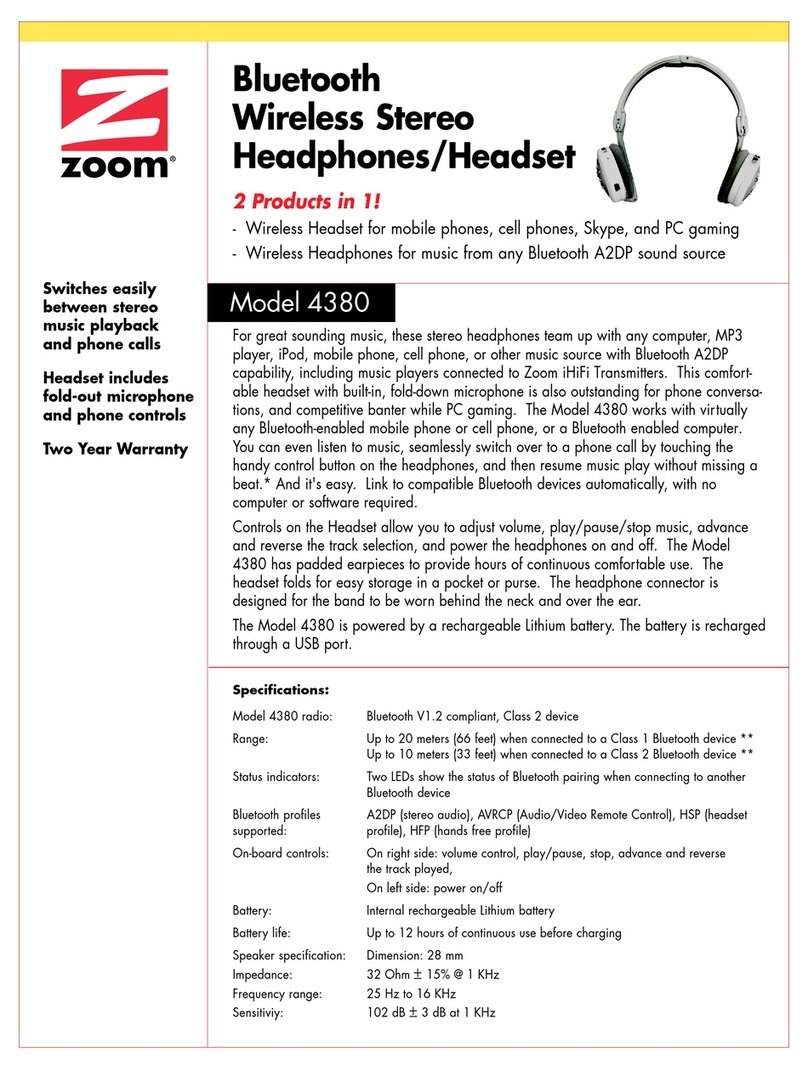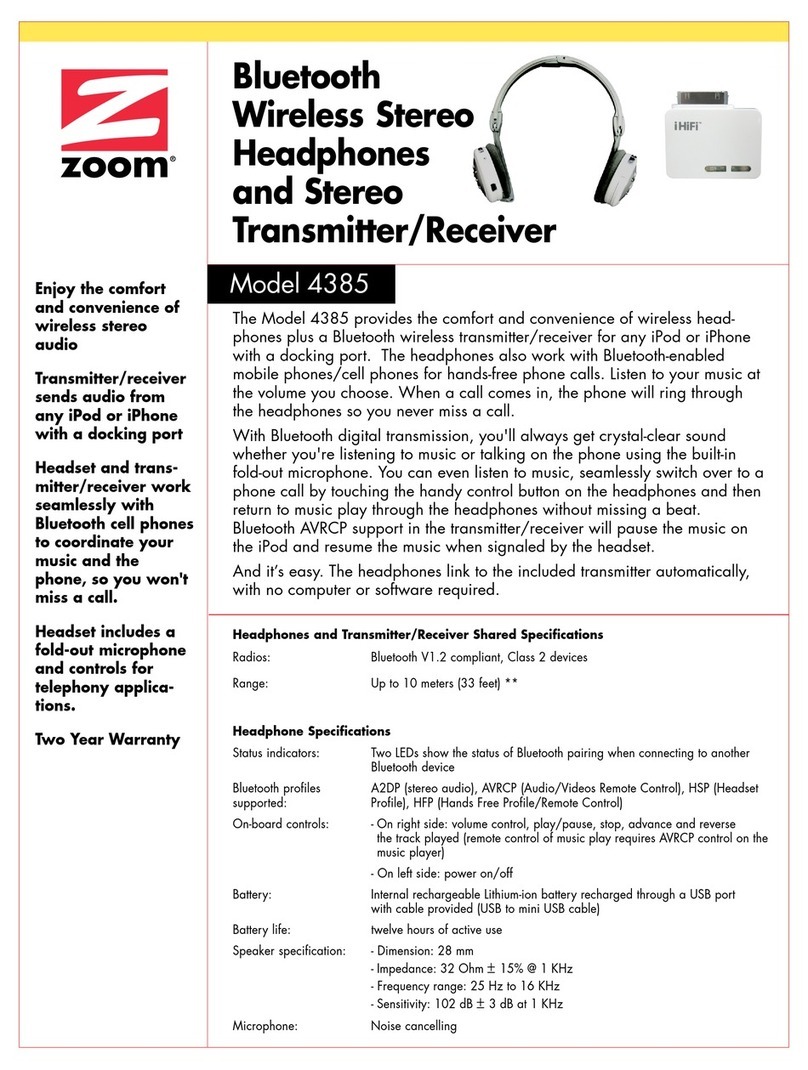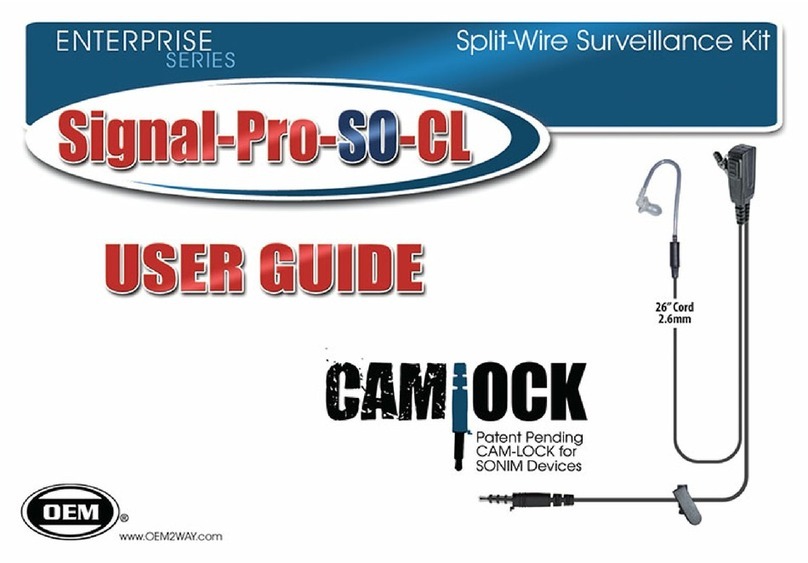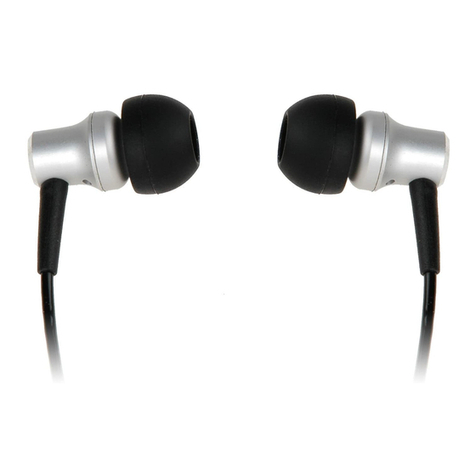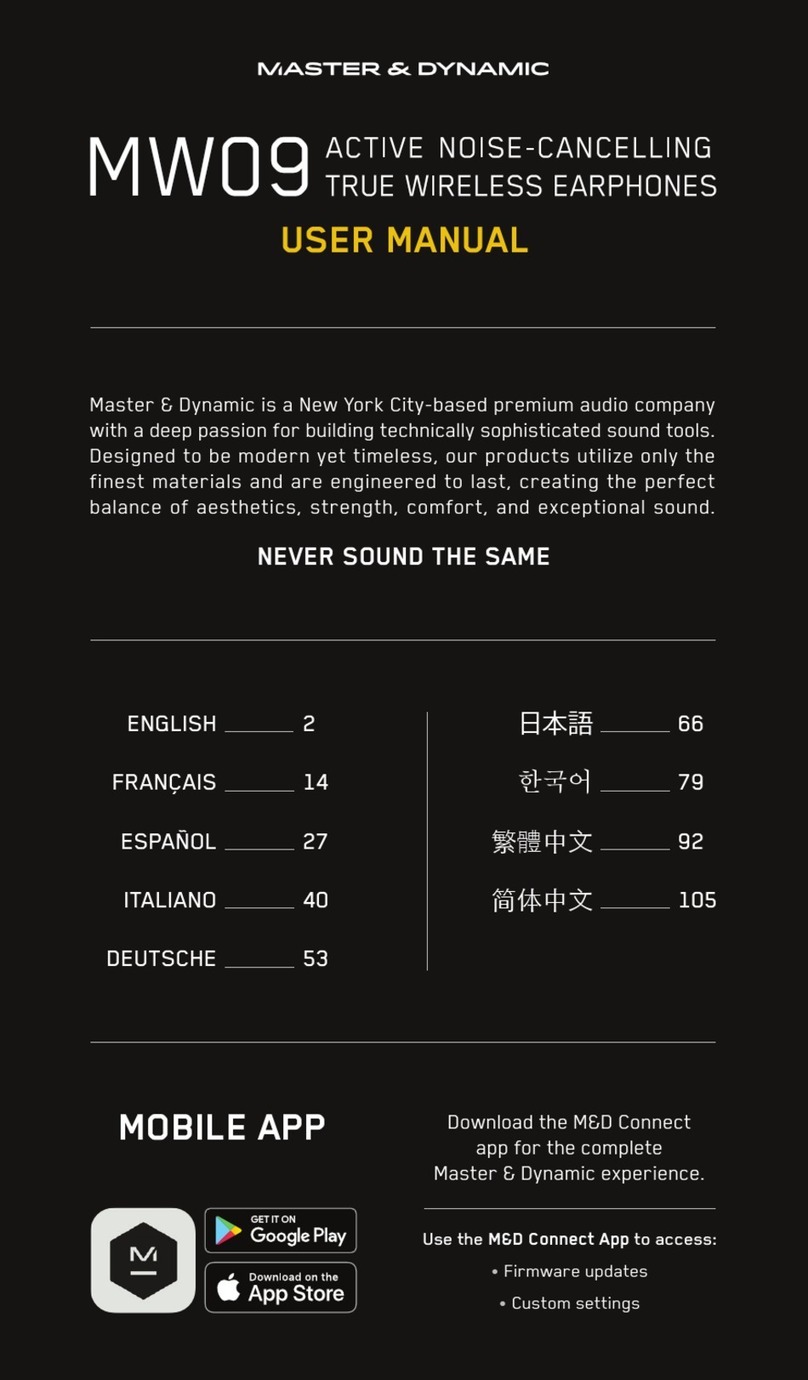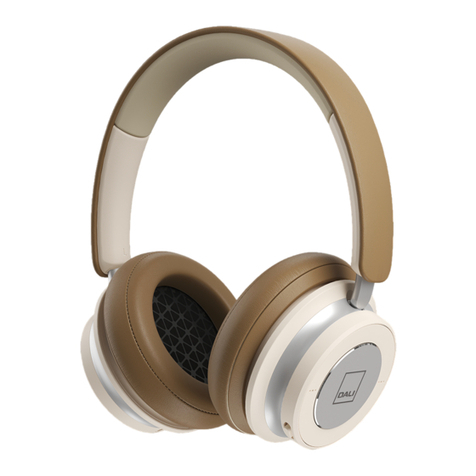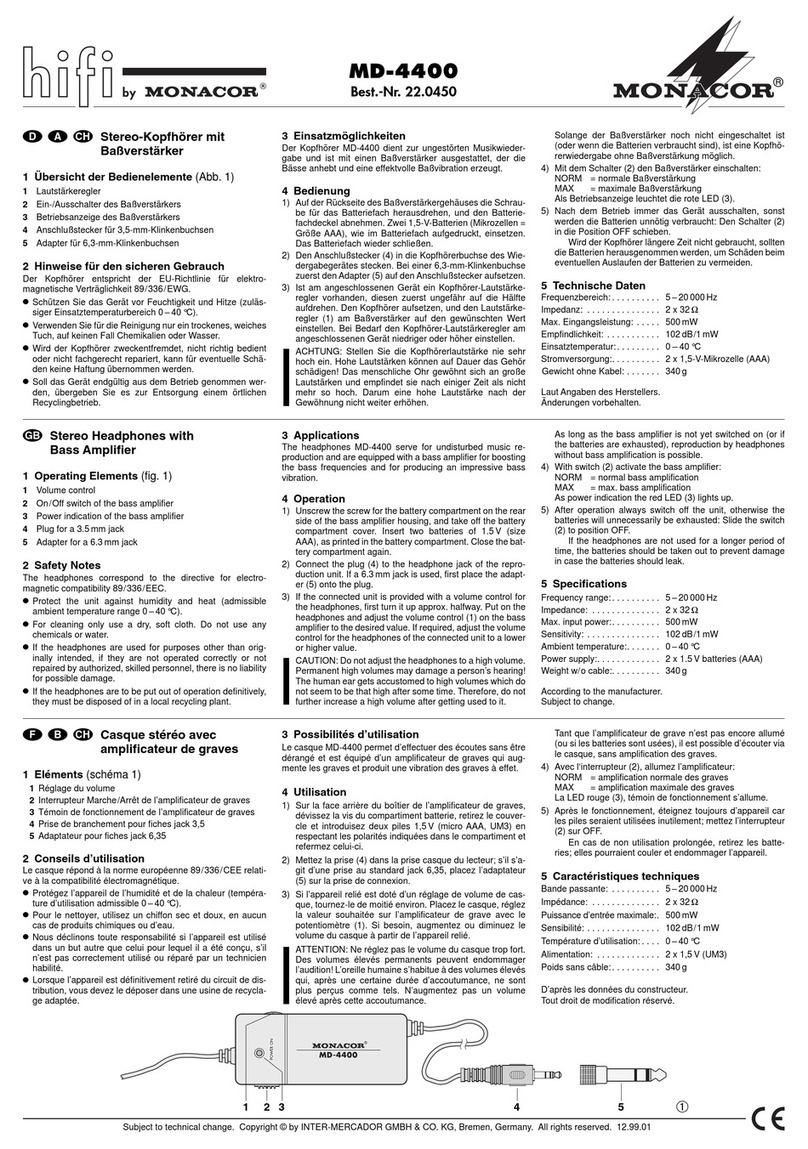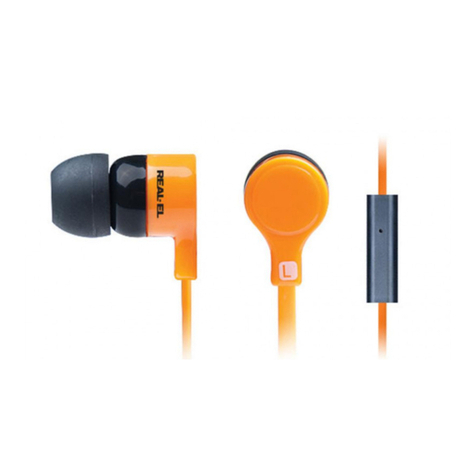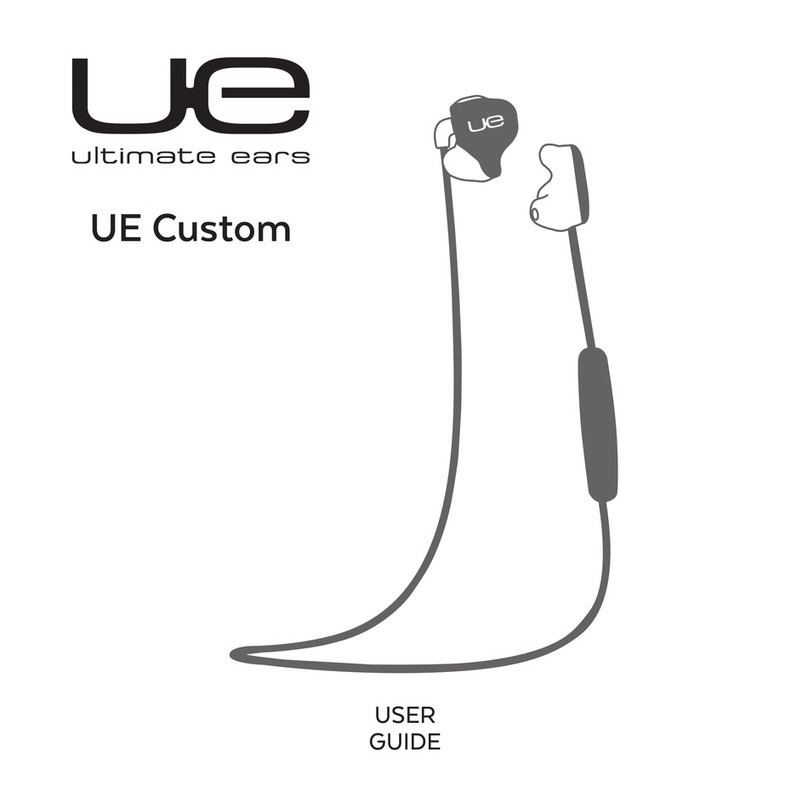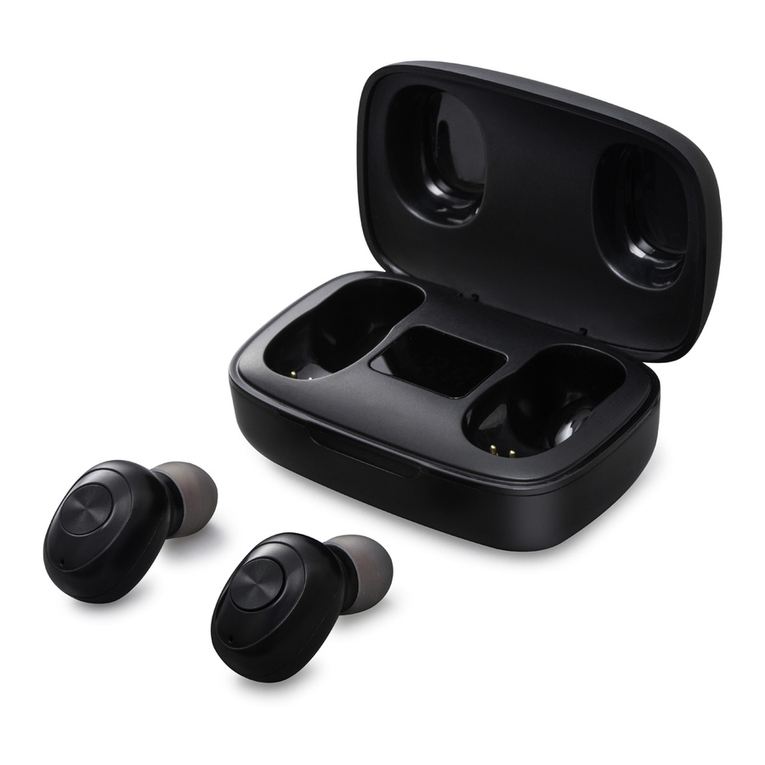Zoom 4355 User manual

2

Zoom®iHiFi™ Bluetooth®Stereo
Headphones/Headset
These instructions are for a device that can function either as
headphones for listening to music or as a headset with a built-
in microphone for phone calls. In these instructions we’ll
simply call the device Headphones.
The instructions cover the following:
•Charging the Headphones
•Pairing the Headphones with various devices including
PCs, cell phones, and iHiFi transmitters
•Using the Headphones
•Some other iHiFi™ products
1. Charging the headphones
3
USB charging jack
Charging
LED
On/Off (1/0) switch
Charging cable

4
1Plug one end of the supplied USB charging cable into the
Headphones’ charging jack.
2Plug the other end of the charging cable into the USB port
of a computer that is powered on.
The Headphones’ charging LED is red during charging,
and turns green when the headphones are fully charged.
3When the LED turns green, unplug the charging cable from
the Headphones. The charge lasts about 12 hours.
If you’re not using the Headphones, make sure the On/Off
button is Off.
Note: Zoom also offers an iHiFi charger (Model 22126F) for
charging without a PC. See www.zoom.com for more
information.
2. Pairing the Headphones
Headphone pairing establishes a wireless link between the
Headphones and another Bluetooth device – or two other
devices, if you want to make or receive a phone call while
you’re listening to music, for example (see page 11). The
device can be almost any Bluetooth device that sends or
receives sound, as long as the device supports A2DP
(Advanced Audio Distribution Profile) and a pairing PIN code
of 0000.
Some of these devices will support basic functionality, but
may not support use of the Headphones for volume control,
pause and other functions, so we recommend Zoom iHiFi
devices for best results.
Whatever the appropriate Bluetooth device, there’s typically a
way to set the pairing PIN code to 0000 and initiate pairing.

After you initiate a device’s pairing, switch the Headphones’
On/Off (1/0) button from Off to On. The Pairing mode LED will
flash blue and red until pairing occurs. At that point the LED
will flash blue for about 10 seconds and then turn off.
Pairing LED Status Explanation
Red/blue alternate
flashing
Searching for a device
or
pairing
Blue flashing Paired. After 10 seconds, the LED
turns off.
Intermittent blue
flashing
Idle (not paired). After 3 minutes,
headphones go into Sleep mode and
LED turns off.
Intermittent red
flashing
Low battery
No indication Paired or in Sleep mode
Pairing
LED
After two devices are paired, they normally remain paired
unless a new and inconsistent pairing occurs.
5

If your unit fails to pair with a desired device, move the
Headphones closer to the device and start the pairing process
again.
Pairing usually takes only about 10 seconds. However,
successful pairing can take up to 3 minutes if the two pairing
Bluetooth devices aren’t near each other or if there are other
wireless devices nearby.
When a Bluetooth transmitter is switched on, it will typically try
for 10 seconds to pair with the most recently paired device. If
the most recently paired device is not found (because, for
instance, it’s off), then a typical transmitter will enter pairing
mode and try to pair with another Bluetooth device.
If pairing doesn’t occur within 3 minutes, a typical transmitter
enters Idle mode and stays in Idle mode until it’s powered off
and then on again.
Pairing the headphones with a PC
To send sound to the headphones, the PC needs to have
Bluetooth capability that supports A2DP (Advanced Audio
Distribution Profile) for sound. To support additional functions
that are built into the headphones, such as volume control and
pause, Bluetooth AVRCP (Audio/Video Remote Control
Protocol) is required. Note that some computers come with
basic Bluetooth that lacks either A2DP or AVRCP.
A PC with Bluetooth normally has built-in Bluetooth or a
Bluetooth adapter such as a USB or PC Card adapter.
If the PC supports Bluetooth, it has related software that may
be called, for instance, a Bluetooth Setup Wizard.
1Select the Bluetooth icon in your system tray or on your
desktop to open the Bluetooth software.
6

7
2Look for a menu option to discover new devices in the
area. When you click this menu option, a list of Bluetooth
devices will appear on your screen.
3Select the Bluetooth Headset (to use the Headset
capabilities for making hands-free VoIP calls) or the
Headphones (to use the Headphone capability for listening
to a podcast or music stored on your computer) and enter
a PIN code of 0000.
4Use the software to initiate pairing.
5After you initiate the PC’s pairing, switch the headphones’
On/Off (1/0) button from Off to On.
6The headphones’ Pairing LED will flash blue and red until
pairing occurs. At that point, it will flash blue for 10
seconds and then turn off.
7That’s it! Now you can exit the Bluetooth Setup Wizard and
go to Section 3, Using the Headphones.
Pairing the headphones with a Bluetooth-enabled
mobile/cell phone
1Turn on your phone and access the Bluetooth settings
section of the phone's menu.
2Make the phone visible (discoverable) to other Bluetooth
devices.
3Search for new devices.
4When the phone displays BT AV Headset, initiate pairing
with the Bluetooth Headphones.
5At the prompt, enter a pairing PIN code of 0000 and make
the connection.

8
Note: Some phones also require you to tell them to
connect to the paired device.
6That's all you need to do! You don't have to do anything on
the Headphones. The Pairing LED on the Headphones will
flash blue for 10 seconds, then turn off. Now go to Section
3, Using the Headphones, on page 12.
If your phone fails to pair with the Headphones, move the
Headphones closer to the phone and start the pairing process
again.
Pairing the headphones with an iHiFi transmitter
Zoom makes many different iHiFi transmitters, including one
for iPods and one for MP3 players and other audio devices.
Pairing instructions for those devices are below.
•Zoom’s Model 4355 iHiFi Transmitter for iPods plugs
into the docking port of any iPod. To pair it with the
Headphones:
1Put the Headphones near the iPod.
2Plug the Transmitter into the iPod.
3Promptly switch the Headphones’ On/Off (1/0) button
from Off to On.
The Headphones’ Pairing mode LED will flash blue and
red until pairing occurs. At that point, it will flash blue for 10
seconds and then turn off.
The iPod Transmitter LED also flashes blue and red during
pairing. After pairing occurs, the LED flashes blue
intermittently.

•o the
one jack of an iPod/MP3 player and other
H
d
3ess and hold the
4
ds and then turn off.
ur cell
co
1
ated within a few
Zoom’s Model 4353 iHiFi Transmitter plugs int
stereo headph
audio devices. To pair the Transmitter with the
eadphones:
1Make sure that the Transmitter is charged up an
plugged into the audio device.
2Put the Headphones close to the Transmitter.
Switch on the Transmitter, then pr
Transmitter’s Connect button for five seconds until the
Transmitter’s lights start to flash.
Switch the Headphones’ On/Off (1/0) button from Off to
On.
The Headphones’ Pairing mode LED will flash between
blue and red until pairing occurs. At that point, the LED
will flash blue rapidly for 10 secon
To pair the Headphones with both your music player and your
computer at the same time, see below.
To pair the headphones with your music player and yo
phone at the same time, see page 11.
Pairing with an iPod or MP3 Player and your
mputer at the same time
Make sure the Headphones are turned on, paired with an
iHiFi Transmitter (see above), and loc
meters (30 feet or less) of both the music player and your
Bluetooth-enabled computer.
9

2Double-click the Bluetooth icon in your system tray or
on your desktop to open the Bluetooth configuration
3th devices in the area,
4
quickly with the computer, and the
pairi turn off.
on
software, and follow the prompts.
When you see a list of Bluetoo
select BT AV Headset.
When prompted, enter a pairing (security) code of 0000
and start the pairing process.
The headset will pair
ng LED will flash blue for 10 seconds and then
(If pairing doesn't occur, see the description of pairing
page 4for help.)
If you hear your VoIP phone ring through the
Headphones while you are listening to music, press the
Phone button on the Headphones and flip down the
microphone to answer the call.
To make a call over the Internet while you are listening to your
music p
on't
a button on the Headphones.
layer, just enter the phone number on your VoIP
provider's web site and flip down the microphone – you d
need to press
When the call is finished, flip up the microphone and
press the Forward/Phone button to listen to your music
player again.
Note: If you pair the Headphones first with your iPod or MP3
uter
player, and you then have difficulty pairing with your
computer, turn off pairing and initiate pairing on the comp
first.
10

Pa
mobile/cell phone at the same time
n
and located within a few
ccess the Bluetooth settings
nu.
5iring
e
to tell them to
connect to the paired device.
T n
t e Headphones will
flash blue
iring with an iPod or MP3 Player and your
1Make sure the Headphones are turned on, paired with a
iHiFi Transmitter (see page 8),
meters (30 feet or less) of both the music player and the
phone.
2Turn on your phone and a
section of the phone's me
3Make the phone visible (discoverable) to other Bluetooth
devices.
4Search for new devices.
When the phone displays BT AV Headset, initiate pa
with the Bluetooth Headphones.
6At the prompt, enter a pairing PIN code of 0000 and mak
the connection.
Note: Some phones also require you
hat's all you need to do! You don't have to do anything o
he Headphones. The Pairing LED on th
for 10 seconds, then turn off.
Note: Please consult the phone's documentation if you
need more information about pairing.
When you hear the phone ring through the
Headphones while you are listening to music, press
the Phone button on the Headphones and flip down the
microphone to answer the call.
11

To make a
number on
the Hea ph
, flip up the micro-phone
on to end the call and
call while you are listening to music, just dial the
your phone – you don't need to press a button on
ones.d
When you finish speaking
and press the Phone butt
listen to your music player.
3. Using the Headphones
12
In the following table, the phone functions are shown in italics.
Stop
Pairing LED
Volume
Down
(
)
Play/Pause
Back
F rwaro d/Phone
Microphone
Volume Up ( )

Button Function
Forward
Or
Answer/end
phone call
Plays the next song. To skip forward two
songs, press twice; to skip forward three,
press three times, etc.
Lets you answer/end a phone call.
In Idle state, hold down 2 seconds to
redial the most-recently dialed number.
Pairing LED
Flashes red and blue while pairing (see
page 5for more information).
Back
Plays previous song. To skip back two
songs, press twice; to skip back three,
press three times, etc.
Microphone Flips down for phone conversations.
Play/ Pause
Toggles music on and off.
During a phone call, mutes/unmutes the
microphone.
Stop
Ends music.
To power off, hold for 4 seconds.
To power back on and initiate pairing,
hold for 4 seconds.
Rejects an incoming phone call.
Volume up
Increases volume. System beeps at
maximum.
Volume down
Decreases volume. System beeps at
minimum.
13

14
4. Some other Zoom iHiFi products
In addition to the iHiFi Transmitter for iPod and the iHiFi
Transmitter for MP3 Players described above, the following
Zoom iHiFi products may interest you.
Model 4360 iHiFi Receiver plugs into a stereo or powered
speakers. It wirelessly receives and plays audio from an iPod,
MP3 player, computer, or other device that has Bluetooth
A2DP capability. The Receiver works with iHiFi Transmitter
model 4355 for the iPod and with model 4353 for MP3 and
other audio players.
Model 4411F and 4321F Zoom USB Bluetooth Adapters
plug into a PC and communicate wirelessly with iHiFi Model
4380 Headphones, the iHiFi Model 4360 Receiver, and other
Bluetooth devices.
Regulatory Information
U.S. FCC Part 15 Emissions Statement
This equipment has been tested and found to comply with the limits for a Class
B digital device, pursuant to part 15 of the FCC Rules. These limits are
designed to provide reasonable protection against harmful interference in a
residential installation. This equipment generates, uses and can radiate radio
frequency and, if not installed and used in accordance with the instructions, may
cause harmful interference to radio communications.
However, there is no guarantee that interference will not occur in a particular
installation. If this equipment does cause harmful interference to radio or
television reception, which can be determined by turning the equipment off and
on, the user is encouraged to try to correct the interference by one or more of
the following measures:
•Reorient or relocate the receiving antenna.
•Increase the separation between the equipment and receiver.
•Connect the equipment into an outlet on a circuit different from that to which
the receiver is connected.
•Consult the dealer or an experienced radio/TV technician for help.

Declaration of Conformity
Déclaration de conformité Konformitätserklärung
Δήλωση Συμμόρφωσης Dichiarazione di conformità
Deklaracja zgodności Declaração de Conformidade
Declaración de conformidade Konformitetsdeklaration
Uyum BeyanatıCam kết vềsựtuân thủởChâu Âu
Manufacturer/Producent/Fabrikant/
Constructeur/Hersteller/
Κατασκευαστής/Fabbricante/
Fabricante/Tillverkare/Üretici/
Nhà sản xuất
Zoom Technologies, Inc.,
207 South Street,
Boston, MA 02111, USA
617-423-1072 www.zoom.com
Brand/Varemærke/Merk/Marque/
Marke/Μάρκα/Marchio/Marka/Marca/
Märke/Thương hiệu
Zoom Bluetooth Stereo
Headphones/Headset
Type/Typ/Μάρκα/Tipo/Türü/Kiểu mẫu Model 4380
The manufacturer declares under sole responsibility that this equipment is
compliant to Directive 1999/5/EC via the following. This product is CE marked.
Producenten erklærer under eneansvar, at dette udstyr er i overensstemmelse
med direktivet 1999/5/EC via følgende. Dette produkt er CE-mærket.
De fabrikant verklaart geheel onder eigen verantwoordelijkheid dat deze
apparatuur voldoet aan Richtlijn 1999/5/ EC op grond van het onderstaande. Dit
product is voorzien van de CE-markering.
Le constructeur déclare sous son entière responsabilité que ce matériel est
conforme à la Directive 1999/5/EC via les documents ci-dessous. Ce produit a
reçu le marquage CE.
Hiermit erklärt Zoom die Übereinstimmung des Gerätes modem mit den
grundlegenden Anforderungen und den anderen relevanten Festlegungen der
Richtlinie 1999/5/EC. Dieses Produkt ist das gekennzeichnete CE.
Οκατασκευαστής δηλώνει με αποκλειστική του ευθύνη ότι αυτό το προϊόν
συμμορφώνεται με την Οδηγία 1999/5/ΕC μέσω των παρακάτω. Αυτό το προϊόν
φέρει τη Σήμανση CE.
15

Il fornitore dichiara sotto la sola responsabilità che questa apparecchiatura è
compliant a 1999/5/EC direttivo via quanto segue. Questo prodotto è CE
contrassegnato.
Producent stwierdza że to urządzenie zostało wyprodukowane zgodnie z
Dyrektywą1999/5/EC. Jest to potwierdzone poprzez umieszczenie znaku CE
na urządzeniu.
O fabricante declara sob sua exclusiva responsabilidade que este equipamento
está em conformidade com a Directiva 1999/5/EC através do seguinte. Este
produto possui Marcação CE.
El fabricante declara bajo su exclusiva responsabilidad que este equipo
satisface la Directiva 1999/5/EC por medio de lo siguiente. Este producto tiene
marca CE.
Bu ürünün imalatçısıtüm sorumluluk kendisinde olmak kaydıyla bu cihazın
aşağıdaki tabloda gösterilen biçimde 1999/5/EC (R&TTE Yönetmeliği) no.lu
Yönetmeliğe uygun olduğunu beyan etmektedir. Bu ürün CE İşareti
taşımaktadır.
Nhà sản xuất cam kết với trách nhiệm của mình là thiết bịnày tuân theo Hướng
dẫn 1999/5/EC thông qua các mục sau. Sản phẩm này được đánh dấu là CE.
16
73/23/EEC – LVD EN 60950-1:2001
89/336/EEC – EMC
EN 55022: 1998/A1:2001/A2: 2003
EN 301 489-1, v1.4.1: 2002
EN 301 489-17, v1.2.1: 2002
EN 300 328, v1.6.1: 2004
Andy Pollock, 14 December, 2007
Director, Hardware Engineering /Direktør,
Hardware Engineering /Director, Sustaining
Engineering /Directeur, ingénierie de soutien
/Direktør, Sustaining Engineering
/Διευθυντής, Μηχανικής Διατήρησης
/Direttore, Hardware Engineering /Dyrektor,
Inżynieria ciągła/Director, Engenharia de
Manutençã /Director, Ingeniería de
apoyo/Donanım Mühendisliği, Müdür/Giám
Đốc Kỹthuật Phần cứng
4380/TF
Boston, MA, USA

Audífonos Zoom®iHiFi™ Bluetooth®
Estéreo
Estas instrucciones son para un dispositivo que puede
funcionar ya sea como unos audífonos para escuchar música
o como los auriculares con un micrófono incorporado para
llamadas telefónicas. En estas instrucciones simplemente
llamaremos el dispositivo Audífonos.
Estas instrucciones cubren lo siguiente:
•Como cargar los Audífonos
•Como emparejar los Audífonos con varios dispositivos
incluyendo PCs, teléfonos celulares y transmisores iHiFi
•Como usar los Audífonos
•Algunos otros productos iHiFi™
1. Como Cargar los Audífonos
Interruptor
Encender/Apagar
(1/0)
Enchufe para
cargar la USB
Luz LED
para cargar
Cable para
cargar
17

18
1Conecte un extremo del cable para cargar USB que le ha
sido enviado cable en el enchufe de carga de los
Audífonos.
2Conecte t el otro extremo del cable de cargar en el puerto
USB de un computador encendido.
La luz LED de cargar de los Audífonos tendrá color rojo
durante el proceso de carga y se volverá de color
verdecuando los audífonos estén totalmente cargados.
3Cuando la luz LED se vuelva de color verde desconecte el
cable de cargar de los Audífonos. La carga dura alrededor
de 12 horas.
Si no esta usando los Audífonos asegúrese que el botón
Encender/Apagar este apagado.
Nota: Zoom también ofrece el cargador iHiFi (Modelo
22126F) para cargar los Audífonos sin usar un PC. Para
mayor información vaya a www.zoom.com.
2. Como Emparejar los Audífonos
El emparejamiento telefónico establece un enlace inalámbrico
entre los Audífonos y otro dispositivo Bluetooth – u otros dos
dispositivos, si desea hacer o recibir una llamada telefónica
mientras esta escuchando música, por ejemplo (vea la página
22). El dispositivo puede ser casi cualquier dispositivo
Bluetooth que envie o reciba sonido siempre y cuando el
dispositivo soporte A2DP (Perfil Avanzado de Distribución de
Audio) y un código PIN de emparejamiento 0000.
Algunos de estos dispositivos soportan la funciones básicas
pero puede que no soporten el uso de los Audífonos para el
control del volumen, pausa y otras funciones, por lo tanto

19
recomendamos el uso de dispositivos Zoom iHiFi para
obtener mejores resultados.
Cualquiera que sea el dispositivo Bluetooth adecuado, hay
una forma típica para fijar el código PIN de emparejamiento
en 0000 e iniciar el emparejamiento.
Después que inicie el emparejamiento de un dispositivo,
cambie el botón Encender/Apagar (1/0) de los Audífonos de
Apagado a Encendido. La luz LED del modo de
emparejamiento destellará en color azul y rojo hasta que
ocurra el emparejamiento. En ese momento la luz LED
destellará en color azul por cerca de 10 segundos y luego se
apagará.
Estatus luz LED de
Emparejamiento
Explicación
Destella alternado
rojo/azul
Buscando un dispositivo o
emparejando
Destella en color azul Emparejado. Después de 10
segundos la luz LED se apagará.
Destella intermitente
en color azul
Inactivo (no emparejado). Después
de 3 minutos, los audífonos entran
en el modo Inactivo y la luz LED se
apagará.
Destella intermitente
en color rojo
Batería baja
Sin indicación Emparejado o en modo Inactivo

LED para
Emparejar
Después de que los dos dispositivos estén emparejados, por
lo general permanecen emparejados a menos que ocurra un
emparejamiento nuevo e inconsistente.
Si su unidad falla en emparejarse con el dispositivo deseado,
mueva los Audífonos más cerca del dispostivo e inicie de
nuevo el proceso de emparejamiento.
Por lo general el emparejamiento solo toma cerca de 10
segundos. Sin embargo, el emparejamiento exitoso puede
tomar hasta 3 minutos si los dos dispositivos de
emparejamiento Bluetooth no están cerca el uno del otro o si
hay otros dispositivos inalámbricos cerca.
Cuando un transmisor Bluetooth esta encendido, por lo
general intentará durante 10 segundos de emparejar con el
último dispositivo emparejado. Si el último dispositivo
emparejado no se encuentra (porque, por ejemplo, esta
apagado), entonces un típico transmisor entrará en modo de
emparejamiento e intentará emparejar con otro dispositivo
Bluetooth.
20
Other manuals for 4355
1
Table of contents
Languages:
Other Zoom Headphones manuals



